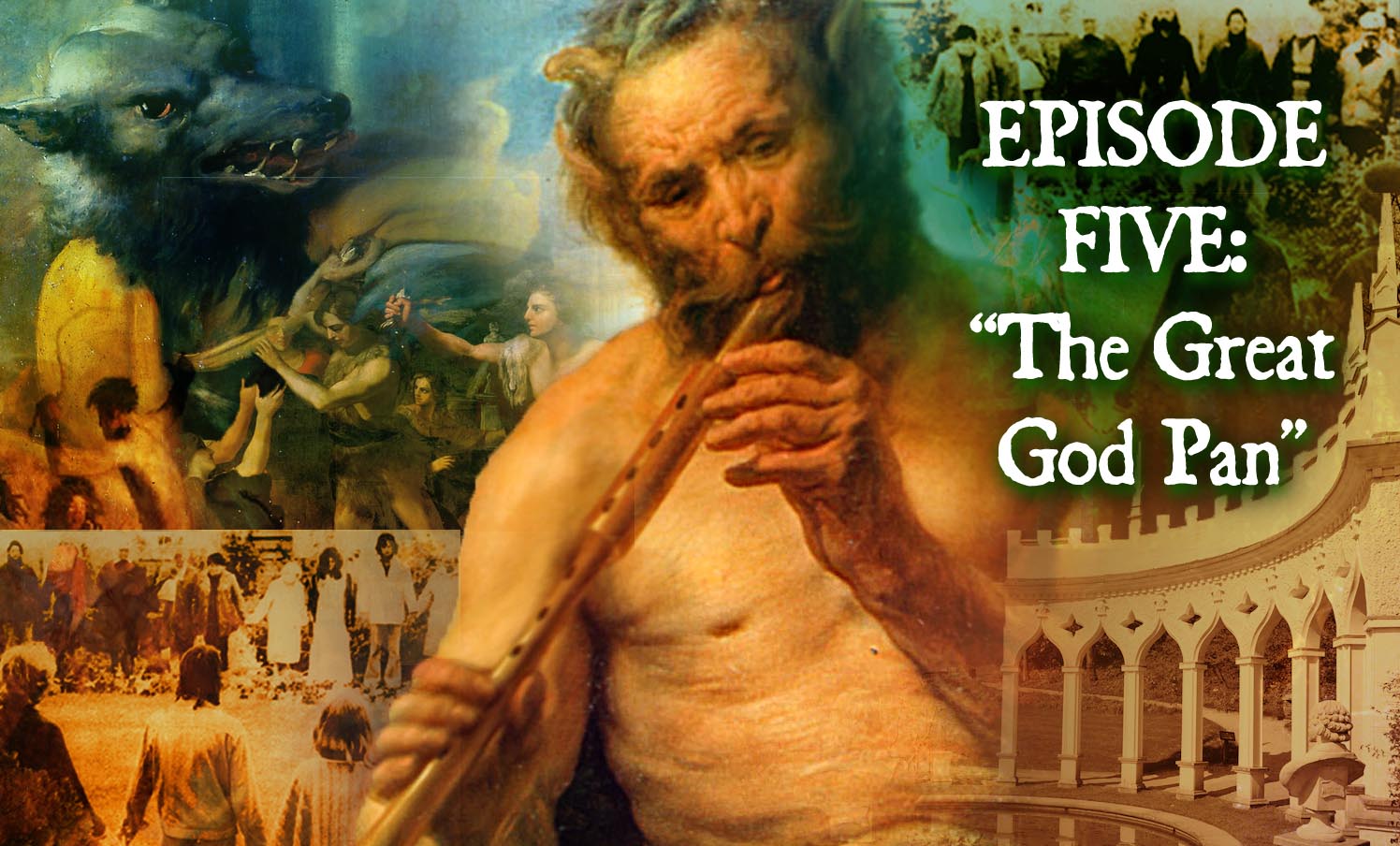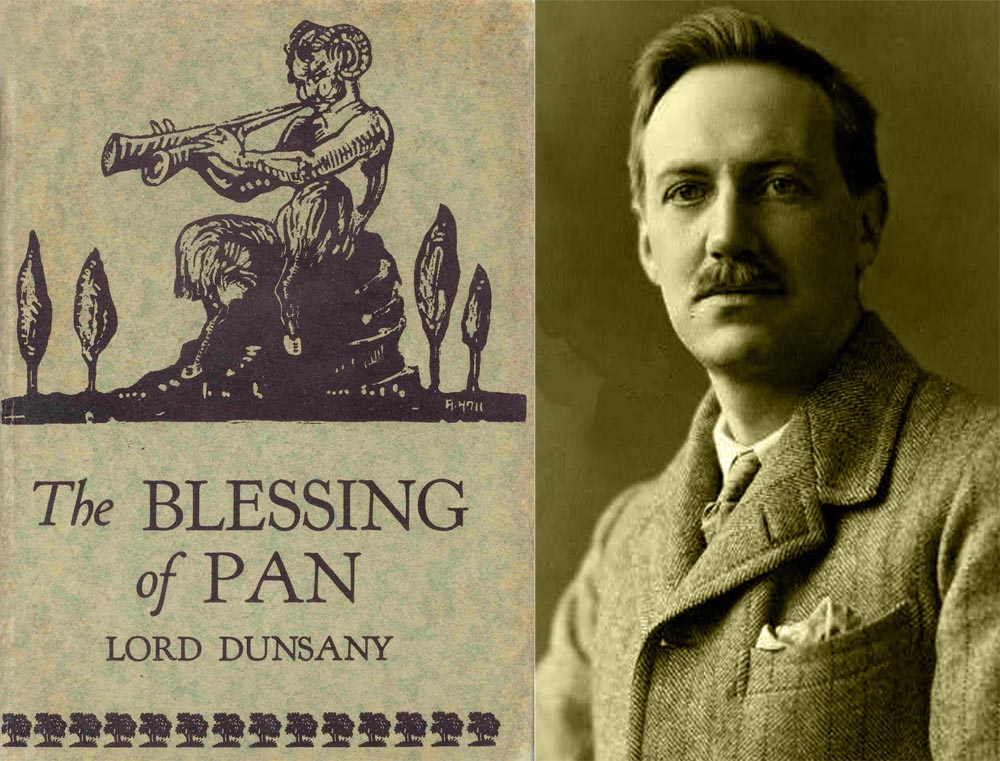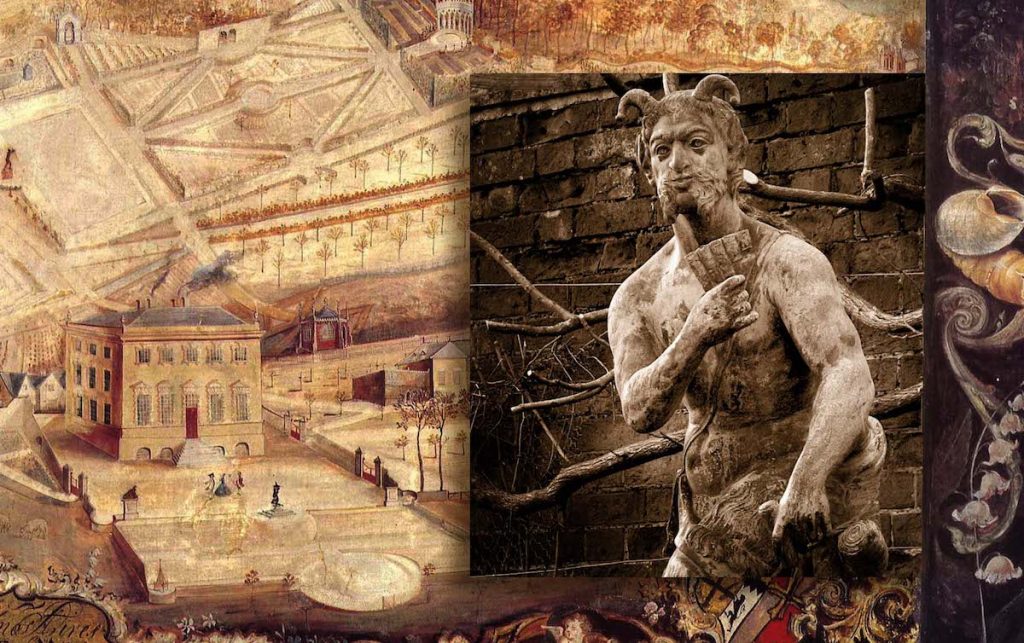Happy Summer Solstice!
Midsummer pagan celebration scene from Tarkovsky’s 1966 film Andrei Rublev about the Russian icon painter. Entire scene with haunting Ovchinnikov score in the clip.
Midsummer pagan celebration scene from Tarkovsky’s 1966 film Andrei Rublev about the Russian icon painter. Entire scene with haunting Ovchinnikov score in the clip.

Podcast: Play in new window | Download (Duration: 36:34 — 33.5MB)
Subscribe: Apple Podcasts | Spotify | Android | Podchaser | RSS | More
We follow our previous episode on the god Pan with a second this week, delving even deeper into the creative and bizarre ways the figure has been embraced after his much publicized “death.”
Our first several minutes are devoted to literary explorations of Pan in the decades around World War I. Naturally we examine only writers providing the more fantastic or horrific examples, including the creator of the high fantasy genre Anglo-Irish writer Edward John Moreton Drax Plunkett, the 18th Baron Dunsany (aka Lord Dunsany). In The Blessings of Pan, he imagines ancient rites to Pan resurrected in the England of his day. If you like what you hear, you might want to have listen to another one of his stories narrated by Vincent Price here.

Wilkinson also provides us a reading from “The Music on the Hill,” by writer Hector Munro, who wrote under the name “Saki”. There is a spoiler in the reading, but it’s pleasingly grisly. We make up for the spoilage by providing you this additional unsettling, darkly comic (to us) story by Saki, one in which a defiant young boy decides to provoke his caretaker by creating a religion around his ferret, whom he names “Sredni Vashtar.” As it turns out, the ferret proves to be a dreadfully vindictive god.
But I digress.
As it turns out, the idea of a return to pagan Pan worship in the Christian era written about by Dunsany and others, may be more than simply a matter of fiction. Our next segment deals with such a case. In 18th-century England, in the town of Painswick, England, a member of the gentry, one Benjamin Hyett, was known to have built “an Arcadian retreat” featuring a building known as “Pan’s Lodge.” You can have a look here at a contemporaneous painting of the lodge grounds and Hyett’s statue (one of two — the other met a curious fate).

Hyett eventually brought the entire community around to join in these rites to Pan. The story grows more complex and curious as these rites are resurrected roughly a century later by a priest who, as we learn, had some intriguing notions about their meaning and origin. Entangled within this story are other local oddities of Painswick culture, including a dish known as “Puppy Dog Pie,” and a practice known as “clipping the church” or “church clipping,” in which members of the congregation join hands and perambulate their place of worship.

Somehow we then arrive at the topic of Lupercalia, the Roman festival involving priests dressed in nothing chasing the Roman woman through the streets with whips. Oddly enough this topic brings us back to Arcadia, home of Pan.

Lupercalia brings us to some interesting myths and tales related to the Arcadian festival Lykaia and King Lycaon, whom Zeus transformed into a wolf (history’s first werewolf, some would say.) Find out what loathsome act drove Zeus to take this action as Wilkinson provides another excellent reading from Ovid.

A bit more ancient Greek werewolf lore, a ghastly story about Pan and his ill-fated pursuit of the nymph Echo, and we end up — of all places — on Summerisle, that is, talking again about The Wicker Man, as we are wont to do. Somehow, the Wicker Man leads us back to Pan. You’l have to just trust me on this.
Benjamin Hyett, was not alone in resurrecting the notion of Pan worship. We find religious devotion to Pan and other pagan nature spirits (as well as inexplicably thriving vegetables) at Northern Scotland’s Findhorn Community. Some clips from a 1973 BBC show make clear their roots in the hippy culture of the era, giving us a bit of background before we meet Findhorn’s primary acolyte of Pan, Robert Ogilvie Crombie (aka ROC). His encounters with Pan in 1970s Edinburgh bring up an interesting point about the difficulties of directly encountering Pan. And naturally, this brings us to our next and final topic.

Arthur Machen’s 1890 horror novel, The Great God Pan was highly influential not only to Lovecraft, but other writers in his circle, and in general on the genre variously identified as “weird fiction” or “cosmic horror.” Neil Gaiman, Guillermo Del Toro, and Arthur C. Clarke have all praised the story. Stephen King has called it “one of the best horror stories ever written. Maybe the best in the English language.”
Once again Wilkinson provides a couple readings of wonderfully morbid passages from the book complete with the usual Bone and Sickle audio ambiance.
We go out with the song “The Great God Pan” from the soundtrack to Mondo Hollywood, a 1967 a documentary in the “mondo” style presenting a mix of LA celebrities and countercultural oddballs, heavy on the oddballs.


Podcast: Play in new window | Download (Duration: 30:51 — 42.4MB)
Subscribe: Apple Podcasts | Spotify | Android | Podchaser | RSS | More
Become a Patron!
In our second episode on the grim folklore of Walpurgisnacht — that is May Eve or April 30, St. Walburga’s day — we meet Walburga, the saint whose name was attached to what was likely a pre-existing pagan holiday.

While the saint’s bones for centuries have been said to be the source of a miraculously curative oil, namesake children dedicated to her have a significantly less holy reputation, with Walburga Oesterreich being a particularly notorious example known for her involvement in a bizarre murder we’ll briefly discuss.
More practices associated with Walpurgisnacht are provided by the highly influential, if a bit outdated, armchair anthropologist Sir James Frazer, of Golden Bough. The association between this day dedicated to the obscure German saint and witchcraft becomes clear as we examine the many prophylactics against evil spirits afoot on the occasion. Listen close so you know what to do with the black and red spotted hemlock! Keep that bonfire stoked…
“So far as the light of the bonfire reaches, so far will a blessing rest on the fields.”

Then we jump into real nexus of that association between witchcraft and Walpurgisnacht, that is, the play Faust by Johann Wolfgang von Goethe, which not only established the night as a notorious witches’ sabbath, but also did much to localize to Germany’s Blocksberg (or Brocken) mountain. A Cliff Notes encapsulation of the witches sabbath scene is rather flippantly re-enacted for your audio enjoyment, wherein you will hear this oft quoted passage from Goethe:
Now, to the Brocken, the witches ride;
The stubble is gold, the corn is green;
There is the carnival crew to be seen,
And Master Urian will come to preside.
So over the valleys, our company floats,
With witches a-farting on stinking old goats.


We discuss the mythology of witches and mountains a bit more generally, surveying a few other German mountains upon which or within which lost souls and dabblers in witchcraft are said to play or reside. Then we get into some details on the Blocksberg relationship to witches, and the 1688 book which spread the reputation of the Blocksberg and inspired Goethe. Herein we are provided with many useful specifics such as the manner of transport the witches use to reach the mountain. Among the methods catalogued: flying with the assistance magic salves or on brooms, shovels, or pitchforks. Or on flying animals: goats, calves, wolves, Cats and dogs are listed. I don’t think it says how the animals can fly.
Along the way, we learn how specific features of the landscape on and around the Brocken have developed their own mythologies and associations. Such tales have always drawn the curious, and Walpurgisnacht tourism associated with this mountain, and indeed the whole legend-rich Harz mountain region wherein the Brocken lies, has grown over the centuries, as attested to by artifacts like the postcards collected below.



While the ominous reputation of the mountain may have lost something in our present day, modern celebrations of Walpurgisnacht are nothing if not enthusiastic… (Below, the “gone viral” video mentioned in the episode.)
Then there’s the Brocken Specter, a weird optical phenomenon that takes its name from the mountain. It appears in low-hanging clouds or mist as a huge, looming, elongated shadowy encircled by a rainbow halo and is caused by the sun behind human figure projecting a shadow on the clouds when atmospheric conditions. More than all my babbling in the podcast, videos like the one below may convey some of its eerie effect…
Last but not least we have a look at paranormal researcher and prankster/publicity hound Harry Price and his shenanigans atop the Blocksberg in 1932. A photo from his highly theatrical reenactment of “The Blocksberg Tryst,” a 15th-century Walpurgisnacht ritual supposedly once conducted on the mountain with miraculous results below…

NOTE: My apologies to all listeners for an uncorrected mispronunciation in Episode 2, namely the hard “G” in the name of the talking Mongoose “Gef” investigated by paranormalist Harry Price. Apparently, the animal informed witnesses that his name was “Jeff,” but was not very good at spelling when called upon to spell it out. You can find more on Gef from our friends at The Folklore Podcast.


Podcast: Play in new window | Download (Duration: 22:58 — 31.5MB)
Subscribe: Apple Podcasts | Spotify | Android | Podchaser | RSS | More
Become a Patron!
Episode One of BONE & SICKLE is the first half of a two-parter about May Eve, Beltane, or as the Germans call it, Walpurgisnacht (“Walpurgis night“) the night of St. Walburga, that and oh so much more!


It’s also about St. George’s Eve, and the conflation of the two in Bram Stoker’s Dracula (and another kind of confusion in Lugosi’s 1931 film of the same name.
Along the way, we meet eccentric English churchman and scholar of folklore and occult, Montague Summers, who provides some interesting nuts and bolts on protecting oneself from evil spirits afoot on Saints George’s of Walburga’s nights. (Sprigs of various herbs placed around doors and windows are a start.) We also learn of what appears to be a strange and little remarked upon money-making hobby Bram Stoker devised for Count Dracula, one referencing actual Romanian superstitions of the 1800s, all of which Stoker had studied up on before embarking on his novel. (Do any readers of the novel remember the mysterious “blue flame” incident (something like a will-o’-the-wisp)?

We also discover what was apparently an early, discarded chapter from the novel Dracula, one rich in references to these earlier landmark works of the gothic genre, these being, Joseph Le Fanu’s Carmilla and Gottfried August Bürger’s 1773 poem Lenore, from which Stoker borrowed the epigraph, “The Dead travel fast” — both of which we’ll explore a bit. Am\nd there’s even a little nod to Walpurgis night.

